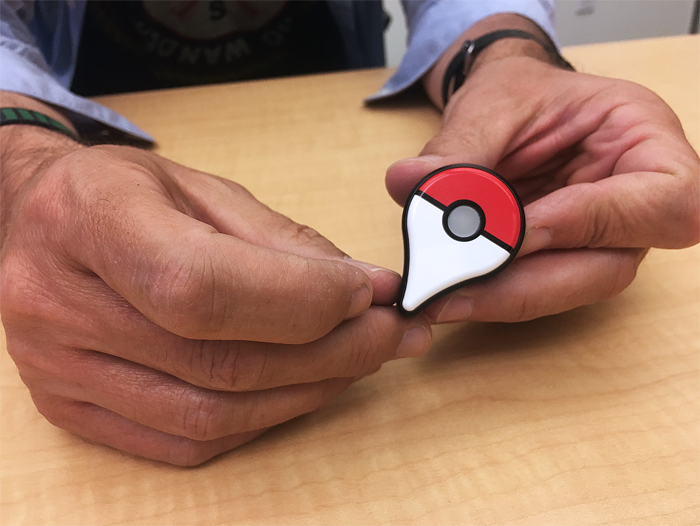It’s 2pm on an SF day so perfect that I’m actually a little tired of small talk about how nice the weather is.
We’re down on the Embarcadero, where the Bay Bridge dominates the horizon. To my left, a clearly overworked guy in a suit shouts into his phone. To my right, its either an outdoor yoga class or a really in-shape cult.
It’s what sits between these two that I care about, though. There’s a Pokémon sitting there, and I want it.
My favorite April Fools’ jokes are those that are just too good to stay fake; those that start their lives as a fun prank, but somehow harness so much energy that they’re almost forced to materialize into something real.
ThinkGeek’s annual gags are a classic example of this — every year, at least one of their phony products generally ends up being demanded into the real world by would-be buyers.
On April Fools’ Day 2014, the Google Maps team released a trailer for a (then fake) augmented reality game that had its players traveling the real world in search of Pokémon visible only through the lens of their smartphone. Nearly 15 million views and many thousands of “SHUT UP AND TAKE MY MONEY!” comments later, they realized they were onto something.
The original (largely CGI) April Fools trailer:
Google’s experiments in augmented reality gaming were spun off into their own company, Niantic. Licensing agreements were worked out with The Pokémon Company. The prank was becoming real. Pokémon Go was born.
When I stopped by Niantic last week, I wasn’t quite sure what to expect.
I played a rainbow of Pokémon titles growing up, stopping only because I realized that the games were eating up more of my life than I’d like. I took “Gotta Catch ‘Em All” as a command. I was hooked.
10 minutes into a demo of Pokémon Go, I felt myself getting hooked again. But this time, I might actually be okay with it.
You see, Pokémon Go isn’t like any Pokémon game before it. It’s not a direct port of the Gameboy games so many of us grew up with. If you go in expecting that, you’ll be sorely disappointed.
Borrowing much of what they’ve learned from Niantic’s first game, Ingress, Pokémon Go is almost less of a game in its own right then it is, for lack of a better word, an excuse… but an excuse to do good things, instead of their faster/more convenient alternatives.
An excuse to give that nagging, lazy part of your brain to explain why you’re walking to work when hopping in a Lyft seems so tempting. An excuse to check out a landmark you’ve seen a million times. An excuse to gather with a bunch of friends at a random spot on the Embarcadero on your lunch break. An excuse to make new friends because they happen to play.

Pokémon Go has you walk around the real world to collect items, catch (and hatch!) Pokémon, and meet up with friends to take possession of “gyms” located at historic landmarks and interesting locations.
I meet up with part of the team behind the game and head off to the Embarcadero, a destination about a mile from where we’re starting. We stop at the base of the Bay Bridge on the way. There’s a virtual item cache hiding there — invisible to the real world, but appearing on the map as a purple icon. Tapping into the cache, we’re presented with information about the bridge — some of its history, and some details on its recently opened new section. Inside the cache itself was a handful of basic Poké Balls (which you use to catch Pokémon in the wild), and a Pokémon Egg. We continue our trek.
About 1/4 mile from the Embarcadero, the phone vibrates. We’re passing another landmark: a set of bronze plaques set into the sidewalk describing many of the animals — most of them hidden away in the waters and marshes of the Bay — that make the area their home. I’ve probably walked over these plaques a thousand times and haven’t ever noticed them.
We arrive at the Embarcadero. Specifically, we’re at Cupid’s Span — an iconic, comically huge statue of a bow and arrow piercing through the soil.

PHOTO CREDIT: DAVE NEWMAN ON FLICKR (USED UNDER CREATIVE COMMONS)
The phone vibrates as we approach. I hold it up — there’s a Pokémon nearby! The iPhone’s camera fades into view, showing me a view of the real world. I pan around the area. Sure enough… about 10 feet away, down near the water of the bay, is a Horsea. Makes sense: we’re by the water, and Horsea is a water Pokémon (Horse + Sea = Horsea. Get it?)
I toss one of the Poké Balls I picked up earlier its way; it misses. My fault, or bad luck? As has always been the case with Pokémon, it’s hard to tell. I toss another, and the Horsea is mine.
“You ready for a battle?” asks one of the games’ developers.
“For what?”
“We’re going to take over Cupid’s Span.”
Turns out Cupid’s Span is, in the world of Pokémon Go, a “gym”.
When you create a character in Pokémon Go, you join one of three teams: yellow, blue, or red. It’s up to you which color you pick, though you’ll generally want to pick the same color as your friends. You’re working together, you see, to conquer the world one gym at a time.
To take over a gym, you have to boot out the Pokémon that are already there. You and your friends can work together to take them on; if you win, you get to leave some Pokémon there to defend it. Battles are fairly simple (it seems mostly about tapping the screen quickly vs. the strategy of the original games.) As more players join, gyms get more and more powerful, capable of holding more Pokémon, and thus harder to take over.
“So might it ever reach a point where you’ll need, say, dozens of people to gather together in one place to take over a gym?”, I ask.
“Oh, absolutely”, one of the devs responds. “That’s what’s supposed to happen.”

The timing of Pokémon Go is rather brilliant, finding its way into the world right as a bunch of things converge: Google’s early experiments with Ingress have already proven that people will be damned near obsessed with this general idea — and that’s without having the energy of an existing IP’s fanbase behind it. Augmented reality is just finding its footing, with things like Google’s Tango potentially opening up a whole new world of insane possibilities.
Perhaps most notably, it’s right in the sweet spot of nostalgia for a lot of twenty somethings — the vast majority of whom own a smartphone, and many of whom might (whether you’d agree or not) feel like they “aged out” of carrying around a Gameboy/DS/anything that isn’t a smartphone for the sake of playin’ some Pokémon.
That’s not to say Niantic won’t face any challenges. They’ll have to deal with balancing the gameplay for an ever growing audience, and ever-constant efforts to tear the game apart by people looking for an advantage — things they’ve faced with Ingress, but that will get kicked up to 11 once they bring in a license/following as big as this one.
They’ll also have to figure out the right way to make money. Right now, that means in-app purchases, with the game itself being free. The company tells me that purchases aren’t meant to be huge competitive advantages — they just speed things (like hatching Poké eggs) up a bit. The challenge, of course, is figuring out how much “a bit” is; finding that balance of making things worth buying without pissing off the players who’d rather spend time than money.
Meanwhile, the company is launching a totally optional companion accessory called the Pokémon Go Plus — a tiny Fitbit-lookin’ dongle that acts as a conduit to the game while your phone stays in your pocket. Walk by a Pokémon or item cache, and a multi-color LED will light up to let you know what’s up. For a company with Google roots, it’s a relatively simple device… but added complexity is added complexity, and it’s curious to launch something like this before the fanbase demands it.

The Pokemon Go Plus dongle. Note that it’s a cross between a Poké Ball and the Google Maps pin, which is just excellent
Speaking of fanbase demands, there’s plenty of room for new stuff here as time goes on. While the game looks like it’s already polished to a glassy smooth degree, it currently lacks things the ability to trade Pokémon — a fundamental staple in almost every prior iteration. Niantic tells me that’s something they’re working on, but they don’t expect at launch.
Overall, though, I’m quite excited for Go, and expect to spend a good amount of time with it when it launches for iOS and Android later this year. It makes me want to walk around San Francisco aimlessly. It makes me want to hang out with other nerds fighting for fake ownership of statues. It makes me want to play Pokémon again.































Comment